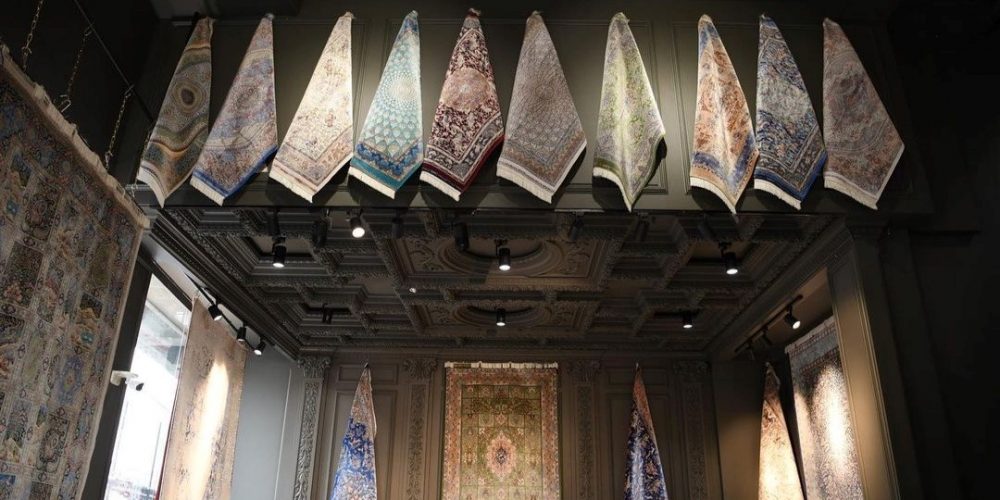Carpets add soul and pleasant warmth to the space and have any house’s unique beauty and originality. However, the increasing demand, the advancement of technology in industrial sectors, and rising prices of hand-knotted carpets in recent years have led to a surge in the production and availability of machine-made carpets/carpets. These affordable and budget-friendly alternatives are produced and woven by industrial machines.

Sometimes, some people mistakenly consider machine-made carpets as affordable carpets. Although most machine-made carpets have reasonable prices, not every machine-made carpet is affordable, and every affordable carpet is not necessarily machine-woven. For example, Kilims and Gabbeh carpets are affordable handwoven carpets.
In the past, when carpets were only woven by hand, due to the use of plants to dye them, the coloring of carpets was always limited to a few colors. But today, thanks to industrial machinery, various carpet colors are available, such as pink, green, blue, beige, black, white, etc. Now everything depends on your choice and desire.

What Are the Materials of Machine-Woven Carpets?
Various machines are employed in their production. These carpets can be made from acrylic or BCF (Bulked Continuous Filament) fibers, including new synthetic fibers such as polyester, nylon and polyester. Carpets crafted from synthetic silk fibers are highly regarded in global markets due to their lint-free nature, easy maintenance, and exceptional durability.
How Long Does it Take for A Machine-Made Carpet to Be Made?
In the vast textile world, machine-made carpets are woven miracles of efficiency. Born in the heart of power looms, these carpets combine precision and speed effortlessly. They can produce many carpets, all mirroring the same length, pattern, and design in a mere wisp of time.
Where hand-knotted carpets are painstakingly crafted over several months or even years, machine-made carpets are born in a flurry of speed and efficiency. These swift creations of the loom, seemingly spun from the very air, are birthed at an astonishing pace.
So swift is their creation that a fully formed, intricately patterned carpet can emerge from the power loom’s clatter in as little as one hour. This speed is a testament to the marvel of modern technology, bridging the gap between tradition and innovation in textiles.

The Advantages of Machine-Woven Carpets
Machine-made carpets are woven with advanced machines, and as a result, the least mistakes are found in their design and color.
Machine-woven carpets have a very low price compared to handmade carpets.
If you can make several of the same carpet designs for different places in the house, machine woven carpet gives you the possibility. Still, handwoven carpets are usually one of a kind.
Machine-woven carpets are safer and more durable for high-traffic areas of the house. Machine-woven carpets do not need special care and are completely resistant and stable against vacuum cleaners and washing.
Machine-woven carpets can be purchased in unique and diverse designs and colors.
Machine-Woven Carpet Size & Design
Firstly, examine the design and size of the carpet. Pay attention to the symmetry of colors in the woven patterns and ensure that shapes and motifs are fully realized without any abrupt cuts or missing elements. Additionally, viewing the carpet in natural light from different angles will help you assess color stability and the overall aesthetic.

The Quality of the Machine-Made Carpet
See the carpets in natural light. Paying attention to the color and motif of the machine-made carpet from different angles and ensuring the stability of its colors are among the important points you should consider when buying it. Carpet piles should be bright and flexible. Machine-woven carpets with soft piles are less durable and absorb more dust than those with thicker piles.
It is possible that a part of the carpet has been damaged due to transfers or folds, and it has been damaged. By carefully checking the back of the carpet, you can see the effects of darning.
The Density of the Machine-Made Carpets
One important criterion for measuring the quality of machine-made carpets is their density, also known as “reed.” These carpets are categorized based on reed count, ranging from 350 to 1700. The density and reed count should be selected according to the intended use and location of the carpet. For instance, higher density and reed counts are preferable for bedrooms and lounges.
Don’t forget to check the back of the carpet in terms of density, weft insertion, and uniformity of design. To check the texture of the machine-made carpet, you should look at its back because the texture quality is more specific in the back of the carpet. By looking at its back, you will notice features like density, number of knots, and uniformity of design.

Roots of the Machine-Made Carpets
Be sure to check the roots of the carpet for rot. The roots of the rotten carpet are easily separated. Although, unlike hand-woven carpets, in machine-woven carpets, the roots are separate pieces from the main carpet and are connected later; the low quality of the carpet roots can also indicate the quality of the carpet itself.


